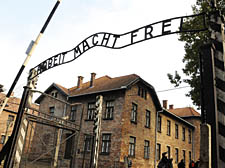| |

‘Work makes you free’ – the notorious slogan above the gates of Auschwitz |
Grim lessons of Auschwitz are still as relevant as ever
The West End Extra spent a day with students visiting the notorious Nazi death camps
AS the nation sat down to the Punch and Judy show with Nick Griffin last week, I was landing at Luton Airport having spent the past 12 hours walking around fascism’s largest graveyard.
The irony of an alleged holocaust denier making the front pages for his Question Time appearance on the day I joined a group of school students at Auschwitz did not go unnoticed.
“Racism is alive and well. Go back and tell your classmates what you have seen today, because people who share the views of the likes of Mr Griffin must be challenged. The alternative is unthinkable,” were the final words of Rabbi Barry Marcus, as he led a mini memorial service at the end of an emotional day for the 250 pupils from across the capital who had travelled to Poland.
If ever there was a warning about what happens if you let prejudice flourish, the gas chambers of the Nazi death camp where more than 1.5 million people died between 1940 and the arrival of the Red Army in 1945 are surely it.
The trip forms the cornerstone of the government-backed Lessons from Auschwitz project – a scheme run by the Holocaust Educational Trust (HET), which aims to send two pupils from every school in the UK to the concentration camp.
The day began with the customary ebullience of schoolchildren who feel like they have cheated a day away from the school gates. And the hubbub showed no sign of diminishing after our first stop, at the site of the only remaining synagogue in the area.
But 40 minutes later, as we pulled up outside the surprisingly picturesque and prim red brick buildings and tree-lined avenues of Oswiecim, better known by its Germanic name Auschwitz, the chatter came to an abrupt halt.
We were guided under the infamous entrance gates bearing the words “Arbeit macht frei” – “Work makes you free” – and set about exploring the horrors of what is now a permanent memorial to the people who died there.
Among the grim exhibits: the human ashes recovered from the crematorium, piles of hair removed from prisoners and most shockingly the mountain of artificial limbs and crutches from the thousands of disabled people who were murdered at the camp.
Students stared in stunned silence.
Then on to the most harrowing part of the tour: the gas chambers.
People arriving at the camp who were deemed too weak to work were told they could shower in a special bathroom. Shower heads were installed to keep the façade up.
Twenty minutes later they were dead.
The second half of the day took us to the bigger and bleaker Birkenau camp. It is here where the iconic images of the watchtower and one way railway track were born.
As one student put it: “Trains are about escaping. Nobody escaped on this line.”
Here we visited the prefabricated horse stables where prisoners slept. Built for 52 horses, each primitive barrack was home to around 400 people, with prisoners so emaciated they could comfortably fit three to a single-bunk tier.
The students ended a long and demanding day with a memorial service for the victims of the camps.
They lit candles and placed them along the railway tracks.
“Now we go back to Krakow airport and our lives go back to normal. The people here were individuals. That’s the most important thing I learned today,” a student told me as we walked back to the coach.
‘We had all seen pictures before, but nothing prepared us for this’
WHERE do I start and what do I say? I had been told before the trip that whatever emotions I might have during the visit wouldn’t be the right or wrong way to feel. But like the majority of students travelling to Auschwitz, we all expected to be upset by the sights we were about to see.
Although I’m sure we had all seen images from these death camps before, it was a whole new experience for me.
Seeing this place in real life made you realise the extremity of the Holocaust. Pictures you see in books or the internet are like only seeing specs of dust in a dust storm.
People will never be able to see the full content of the Holocaust because only the skeleton is left behind.
To my surprise – and don’t take this the wrong way – I found it very difficult to feel upset, simply because you can never really put yourself in the shoes of those who suffered in these camps.
To try and describe my emotions with one word is difficult yet I would say mostly shocked: shocked at the potential cruelty of the human race.
No matter how much we want to forget – because of the horror of the Holocaust, and the shame it represents – it is still necessary to realise the scars these events have left behind.
I highly recommend a visit to Auschwitz, even just to pay respect to those who suffered and died there.
Indiah Redman-Davidson age 17, Pimlico Academy |
 |
|
 |
| |
| |